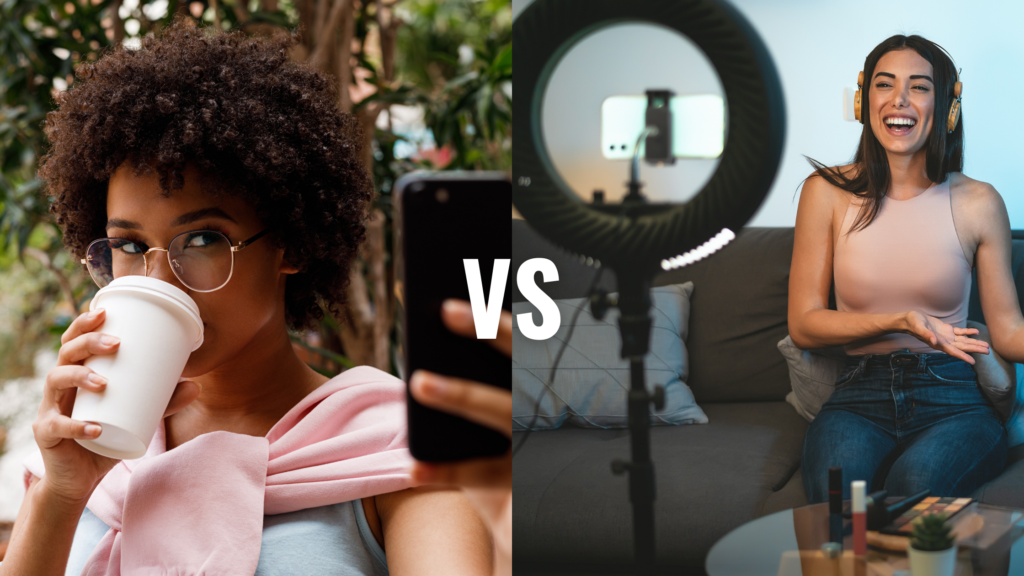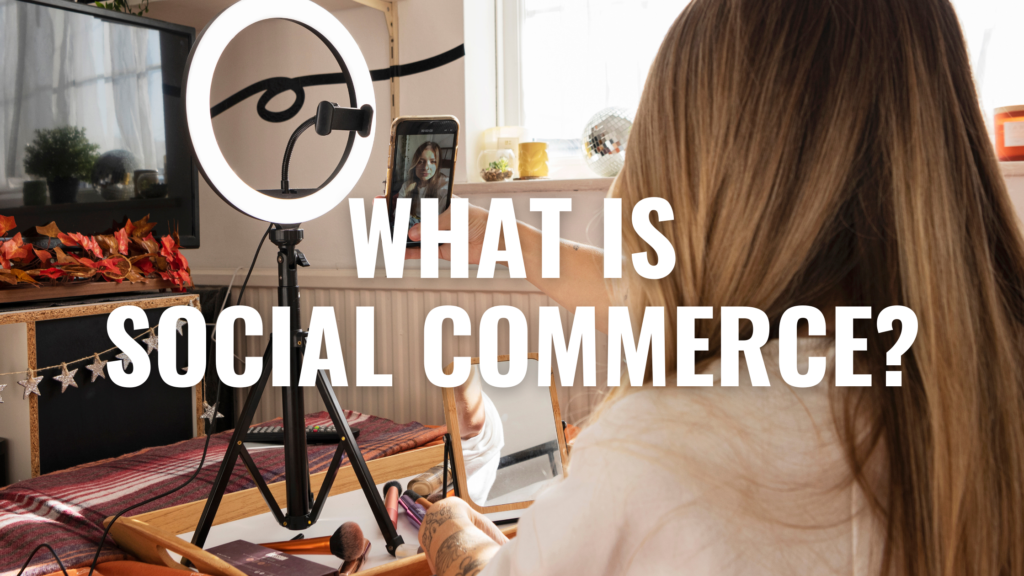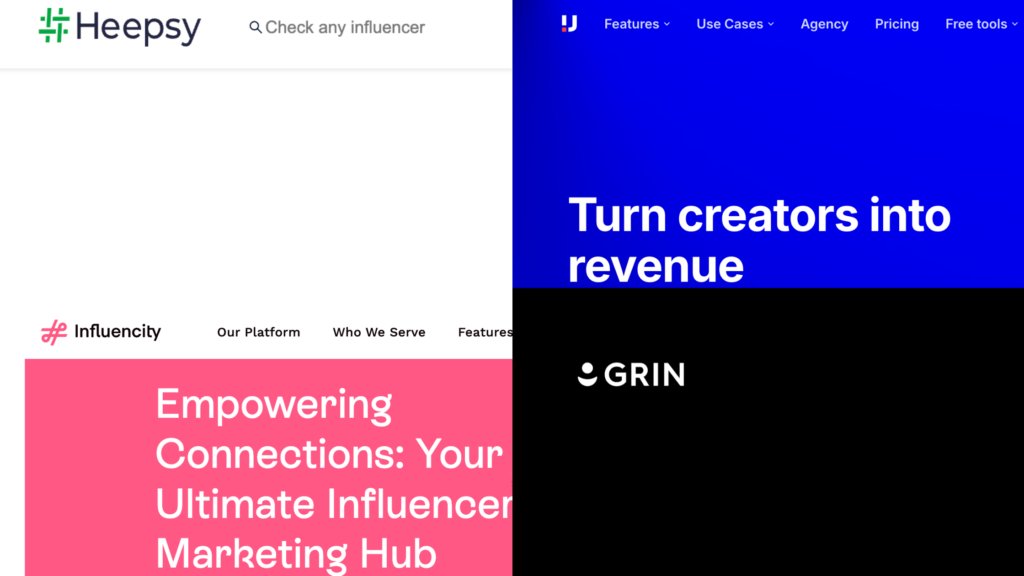When people think of influencer marketing, they often think of fashion, beauty, or lifestyle brands first and foremost. But the truth is influencer marketing works for virtually any e-commerce business that sells a physical product.
Table of Contents
- Understanding What Influencer Marketing Is for E-commerce
- Social Media eCommerce vs Social Commerce
- Finding Influencers To Match Your E-commerce Business
- Define Your Ideal Customer
- Prioritize Niche Relevance Over Follower Count
- Analyze Engagement and Authenticity
- Check Their Content Style and Brand Fit
- Evaluate Past Brand Partnerships
- Tools and Methods for Finding the Right Influencers
- Use Influencer Marketing Platforms
- Leverage Social Media Search Tools
- Analyze Competitor Partnerships
- Use Google
- Engage with Micro-Influencers in Your Industry
- Platforms For E-commerce Influencer Marketing: Strengths & Weaknesses
- Create an Influencer Marketing Campaign For E-commerce
- 1. Define Your Campaign Goals and KPIs
- 2. Choose the Right Influencers
- 4. Craft a Clear Campaign Brief
- 5. Track Performance and Optimize in Real Time
- 6. Repurpose Influencer Content for Maximum ROI
- 7. Build Long-Term Influencer Relationships When Appropriate
- Potential Drawbacks of Influencer Marketing For E-commerce
- Final Tips For E-Commerce Influencer Marketing
The reputation for influencer marketing only working in certain niches still exists in some business circles, and it can limit the growth strategies and scaling opportunities that many founders and entrepreneurs could otherwise enjoy.
In 2025, there’s no reason for any e-commerce brand to not adopt an influencer marketing strategy.
In some cases, business owners know this, but they’re not sure where to start when it comes to influencer marketing for e-commerce.
To help those entrepreneurs, we’ve put together a comprehensive guide on influencer marketing for e-commerce businesses. This guide will take you through the steps to develop a successful strategy without any trial and error that could waste your precious marketing budget.
Understanding What Influencer Marketing Is for E-commerce
Influencer marketing for e-commerce is the partnership between companies and social media creators to promote a business or specific product. This partnership can range from something very simple, like mentioning a product during a creator’s videos. However, it can also be a deeper partnership that involves product development collaboration and even revenue sharing with the influencer.
For brands that were mostly founded on social media, some of this may seem obvious, but many business founders may not be social media savvy. Depending on the niche they’re in, they may have been able to start a successful e-commerce business with minimal social media exposure.
The downside of that approach is that the business is missing out on the largest audience in the world that exists on social media.
Social Media eCommerce vs Social Commerce

With the rise of digital marketing, businesses often confuse social media e-commerce advertising and social commerce as interchangeable strategies. While both leverage social media platforms, they serve distinct purposes and operate differently within an e-commerce strategy. Understanding their differences can help brands optimize their influencer marketing efforts effectively.
Social Media E-commerce Advertising
Social media e-commerce advertising refers to paid promotional efforts designed to drive traffic to an external e-commerce website or landing page. Brands use platforms like YouTube, Instagram, TikTok, and Pinterest to create targeted ad campaigns, often incorporating influencer-generated content to increase engagement and conversions.
Key characteristics:
- Paid promotions: Involves running ads through social media platforms. Most platforms like TikTok, Instagram, and YouTube have their own dedicated system so brands can buy advertising that shows up within content or within user feeds.
- External transactions: With social media eCommerce advertising, customers are directed to a separate website or marketplace to complete purchases. This makes conversions and A/B testing much more critical since there is added friction as consumers move from one app or site to another before making a final purchase.
- Data-driven targeting: Advertisers use audience segmentation, retargeting, and analytics to refine their campaigns. Most platforms supply these metrics although many e-commerce brands will use third-party analytics tools as well to gain more insight or confirm the platform’s data.
- Influencer collaboration: Brands often repurpose influencer content into ad creatives for broader reach. Influencer marketing is often used more effectively than paid ads, although both are used synergistically to boost campaign reach and maintain brand awareness.
Social Commerce

Social commerce, on the other hand, enables customers to browse, shop, and purchase products directly within a social media app. Platforms like Instagram Shops, Facebook Shops, and TikTok Shop integrate e-commerce functionality, allowing seamless transactions without leaving the app. Influencers play a key role in driving sales by promoting products directly within these social shopping experiences.
Key characteristics:
- In-platform shopping: Customers can complete purchases without leaving the social media platform. This significantly reduces friction and can increase conversion rates, specifically for impulse buying or products under a certain price threshold. The downside is that e-commerce businesses may have less control over the checkout process and access to customer data since they remain on the social media platform’s systems.
- Influencer-driven sales: Influencer marketing is still a part of social commerce and it’s similar to social media advertising. Creators can tag products in posts, live streams, or stories, making it easy for followers to buy instantly. One key difference is that creators often earn a commission for products sold. While this also happens in social media e-commerce advertising, it’s more prevalent in social commerce arrangements.
- Algorithm-driven discovery: Social commerce leverages platform algorithms to surface products to interested shoppers organically. Because the social media platform has so much data on customer behavior during social commerce transactions, extreme targeting can be used to drive sales.
Both strategies are valuable in an influencer marketing campaign. As you can see, influencer marketing plays an equal role in both methods.
Finding Influencers To Match Your E-commerce Business
You can’t have influencer marketing without influencers, so your first step toward this strategy will be to find a pool of suitable influencers for your specific e-commerce business. With millions of influencers to choose from on all the different social media platforms, this may seem like a herculean task.
But don’t worry, there are methods and tools that have been developed over the years that significantly reduce the time needed for high-quality influencer discovery.
Partnering with the right influencers can make or break an e-commerce influencer marketing campaign. The key to success is ensuring that the influencer’s audience aligns with your target customers.
Here are some tips to help you find the perfect match:
Define Your Ideal Customer
Before searching for influencers, clearly outline your target audience. Consider factors such as:
- Age, gender, and location
- Interests and lifestyle
- Shopping behaviors and pain points
Matching your influencer’s followers with your ideal customer ensures that your promotions reach the right people. This is often referred to as alignment and it’s one of the key determining factors for whether an influencer marketing campaign is successful. The higher the alignment, the more successful the campaign will be.
Prioritize Niche Relevance Over Follower Count
A smaller influencer with a highly engaged and relevant audience is often more effective than a large influencer with a broad, mixed following. Look for influencers in:
- Your industry (fashion, beauty, tech, fitness, etc.)
- Sub-niches relevant to your products (e.g., eco-friendly beauty, budget travel gear, minimalist home decor)
- Communities that naturally align with your brand values
This doesn’t mean you should avoid influencers with huge follower counts. But as follower counts go up, other metrics will generally decrease to some degree. The more general the content is, the more prevalent this drop-off will be.
For example, if a creator covers general pop-culture topics like celebrity gossip, there will be far more of a drop-off in engagement and other metrics compared to a creator who focuses only on makeup tutorials.
As an e-commerce business that’s creating an influencer marketing strategy, you may find you can get lower sponsorship rates when choosing creators who put out general content. This may seem attractive but the ROI on these creators can often be lower so you don’t really save any money. In fact, you often lose money unless you have a product that has widespread appeal.
Always put a focus on alignment and you’ll have much more success, especially early on. As you gather more data, you can branch out and try to expand your reach.
Analyze Engagement and Authenticity
Follower count alone isn’t enough—engagement matters. Look for influencers who:
- Receive consistent, genuine interactions (likes, comments, shares)
- Have meaningful conversations with their followers
- Avoid influencers with excessive sponsored posts that make their feed look like an ad catalog
Engagement is a two-way street. Every creator wants their audience to engage with their content. That feeds into the platform’s algorithm and helps them grow their audience. However, creators need to also engage with the audience.
These two things go hand-in-hand and you’ll generally notice that creators with low engagement also tend to engage with their audience less. It’s a chicken and the egg type of problem, but as an e-commerce brand, it’s something to be aware of when selecting influencers to partner with
Check Their Content Style and Brand Fit
Review the influencer’s past content to ensure it aligns with your brand’s image and values. Consider:
- Their tone and personality (fun, educational, aspirational, etc.)
- The aesthetics of their posts (high-quality visuals, storytelling, authenticity)
- How they promote other brands (overly salesy vs. naturally integrated)
A good fit will make collaborations feel seamless and trustworthy to the audience.
Evaluate Past Brand Partnerships
Look at the influencer’s history with sponsored content. If they’ve successfully worked with brands in your industry, they likely have an audience that trusts their product recommendations.
Tools and Methods for Finding the Right Influencers
Once you know what to look for, the next step is finding the right influencers efficiently. With millions of creators on different platforms, it can be difficult. But there are many tools available to streamline your search.
Below, we’ll go over your options.
Use Influencer Marketing Platforms

Social media management tools help brands find influencers based on niche, audience demographics, engagement rates, and more. Some popular options include:
- Upfluence – AI-powered influencer search and analytics
- Heepsy – Database of influencers with audience insights
- Influencity – Comprehensive influencer discovery and management
- GRIN – End-to-end influencer relationship management
These platforms make it easier to filter potential influencers based on the criteria that matter most for each e-commerce brand and their marketing strategy.
These platforms charge a fee that ranges from less than $100 a month to over $1,000 per month depending on the level of service and subscription you choose. Many platforms also take a percentage of each contract made through the platform. This is similar to something like eBay, which takes a cut of each purchase on the platform.
In return for those fees, these platforms provide tools to help with communication between the brand and the influencer. They also help with contracts as well as disputes or any issues.
Some platforms even provide content help and collaboration tools to facilitate approval and any changes needed before sponsored content goes live.
The most common drawback of these platforms is that not every creator is on every platform. So the perfect creator for your campaign may not be on the platform you use. However, many platforms have tens of thousands of creators to choose from, so you can generally find exactly what you’re looking for.
Leverage Social Media Search Tools
Each social media platform has its own built-in tools to discover influencers. These are often free and are a very useful and cost-effective method for starting an influencer marketing campaign for e-commerce.
Besides the built-in tools, you can also just browse the platforms to find a list of influencers using these methods.
- Instagram – Use hashtags, explore pages, and engagement on competitors’ content
- TikTok – Browse trending videos in your niche and check creators’ engagement rates
- YouTube – Search for product reviews and unboxings related to your e-commerce niche
- Pinterest – Look for content creators with high engagement on shoppable pins
Analyze Competitor Partnerships
One aspect that often gets overlooked when it comes to marketing is the idea of competitor research. This doesn’t mean copying your competitors, but instead, it’s about finding out what is already working so you can avoid any costly trial and error as you develop your own strategy.
Look at who your competitors or similar brands are collaborating with. If an influencer has successfully driven sales for a similar product, they could be a great fit for your brand as well.
This is especially true if a competitor has been using a specific platform or group of influencers for an extended period of time. That means the competitor is finding great success with that strategy and you should try to replicate that success as much as possible.
Examine each part of the competitor’s strategy separately to find what can be adapted to your own strategy.
Use Google
Search for niche-specific lists of top influencers in your industry. Many marketing websites publish updated lists that can help you discover potential collaborators.
This will usually show the most popular influencers in the niche, but you can narrow the search by using more specific niche terms or influencer sizes.
Engage with Micro-Influencers in Your Industry
Micro-influencers (10K–100K followers) often have highly engaged audiences and may be more affordable. Look for potential brand advocates among:
- Customers who already love your products
- Product seeding
- Niche bloggers or YouTubers creating content in your industry
- Loyal followers who consistently engage with your brand
Micro-influencers aren’t just about saving money either. Many of the largest brands use micro-influencers as part of their overall influencer marketing strategy. This applies to e-commerce businesses as well.
When marketing for e-commerce, you want to build trust which in turn will boost conversions. Influencers with highly engaged audiences can bestow that trust on your brand with a simple mention.
Platforms For E-commerce Influencer Marketing: Strengths & Weaknesses

Each social media platform generally has its own strengths and weaknesses when it comes to influencer marketing success. There is always some overlap, but each platform tends to favor certain industries, products, or niches compared to the other platforms.
In this section, we’ll go over the main social media platforms for ecommerce influencer marketing and explain the strengths and weaknesses of each one.
Instagram influencer marketing is often one of the most successful due to the platform’s immediacy and content options. With over 2 billion active users, Instagram also represents a huge worldwide audience that few brands can afford to ignore.
Instagram tends to work best for brands that focus on creating a lifestyle association with the products and services they sell. Many creators on Instagram invest a huge amount of effort in curating their specific channel’s aesthetic and image. Audiences of those creators expect the brands shown on that channel to match that same image.
This is where alignment comes into play, but when that alignment is 100% correct, it creates a potentially high ROI for marketing spending.
Instagram has many different content options, but typically Reels content has the highest engagement, so that’s where brands often spend their money.
Instagram Reels are short, engaging videos on Instagram that allow users to create and share content up to 90 seconds long. They come with a variety of creative tools, including music, text overlays, AR effects, and editing features like speed control and video alignment.
Reels appear in a dedicated section on Instagram and can be discovered through the Explore page, making them a powerful tool for increasing visibility and engagement.
Instagram generally doesn’t do as well for products or industries that require more in-depth explanations of the unique selling points of the brand being sold. For example, in-depth product reviews, detailed unboxing, and similar content are hard to translate on Instagram.
YouTube
You can almost think of YouTube influencer marketing as the opposite of Instagram when it comes to content styles. The focus is on long-form videos and often videos that are informational or educational in nature.
YouTube is where consumers go to get in-depth knowledge of a product or product category. So if your brand or product requires more explanation, YouTube is where you likely want to focus your influencer marketing budget.
Another strength of YouTube is the engagement rate, which is far ahead of other platforms and can be as high as 47% on average for some types of content. Combined with a user base of 2.47 billion, YouTube is one of the best influencer marketing opportunities for e-commerce businesses.
However, YouTube does have certain drawbacks. The costs to work with influencers on YouTube are generally higher than the other platforms. You also have to compete with paid ads from competitors that may run during the content you sponsored.
TikTok
TikTok is the short-form video king and it’s no surprise what kind of brands can do well on the platform.
What makes TikTok unique and different from Instagram is the more raw and authentic feel of the content produced on the platform. Where Instagram really focuses on creating a lifestyle affiliation through aesthetic choices, TikTok favors more realistic content with less obvious production.
One drawback of TikTok is that there is a very fine line between sponsored content that works and content that falls flat. Without a proper understanding of the format and audience, sponsored content can look out of place.
Create an Influencer Marketing Campaign For E-commerce
There’s a solid blueprint for creating an effective influencer marketing campaign for e-commerce. Below, we’ll outline the steps that top influencer marketing agencies use to develop a strategy for their clients.
1. Define Your Campaign Goals and KPIs
Before launching a campaign, establish clear objectives tied to conversions. Common goals for e-commerce businesses include:
- Increasing direct sales through influencer promotions
- Driving traffic to product pages with high purchase intent
- Growing your email or SMS subscriber list for retargeting
- Boosting customer lifetime value through upsells and repeat purchases
- Driving customers to app download pages.
Key performance indicators (KPIs) to track:
- Conversion rate from influencer-driven traffic
- Revenue generated from influencer discount codes or affiliate links
- Click-through rates on influencer content
- Return on ad spend (ROAS) if repurposing influencer content for paid ads
2. Choose the Right Influencers
Using our tips from earlier, finding influencers who align with your target audience is crucial for maximizing conversions. This is one of the critical steps that determine success, so invest enough time in this process.
Key areas to be aware of when choosing influencers:
- Have an engaged audience that matches your customer demographics
- Regularly promote products in your niche
- Create authentic content that doesn’t feel overly promotional
- Have a history of driving engagement and sales for similar brands
Consider working with a mix of micro-influencers (10K–100K followers) and mid-tier influencers (100K–500K followers) for high engagement and affordability.
4. Craft a Clear Campaign Brief
To ensure consistency and alignment with your brand message, provide influencers with a detailed campaign brief. The content or campaign brief outlines what you expect from the content and ensures there are no surprises or disputes once the creator includes your messaging in their content.
- Key messaging and product benefits to highlight
- Content format expectations (Instagram Reels, TikTok videos, YouTube reviews, etc.)
- Call-to-action (e.g., “Shop now using my exclusive discount code”)
- Posting schedule and deadlines
Avoid overly scripted content—let influencers maintain their authentic voice while promoting your product. The influencer knows their audience the best, so be flexible if they feel changes are needed to your content brief.
Determine what aspects of your message you’re flexible on and what you’re not flexible on in advance to speed up this process and avoid any conflicts.
5. Track Performance and Optimize in Real Time
Once influencers begin posting content, you’ll want to closely monitor campaign performance. Your influencer may also provide their own metrics during this process.
- UTM tracking links to measure influencer-driven traffic and conversions
- Google Analytics to analyze customer behavior from influencer referrals
- Affiliate platforms to track commission-based sales
- Social media listening tools to gauge engagement and sentiment
If a campaign isn’t performing well, consider adjusting the offer, testing new influencers, or repurposing high-performing content into paid ads.
6. Repurpose Influencer Content for Maximum ROI
High-converting influencer content shouldn’t be discarded as you may be leaving money on the table. If something works in marketing, you generally want to lean into it until it stops working or a new strategy starts working better.
There’s no reason to reinvent the wheel with every campaign. If you find something that works, try to expand on it by using the same strategy on other platforms or with other influencers.
7. Build Long-Term Influencer Relationships When Appropriate
One-off influencer campaigns can drive spikes in sales, but long-term partnerships create sustained growth.
- Offering them an ambassador role or exclusive perks
- Providing early access to new products for continued promotion
- Creating affiliate programs that reward long-term conversions
Long-term relationships with influencers are also great for building brand loyalty, authority, and trust within a niche or industry. If your goal is simply sales or a time-sensitive promotion, you don’t have to focus on this as much.
Potential Drawbacks of Influencer Marketing For E-commerce
Influencer marketing can offer a high ROI and the ability to scale. However, it does have certain drawbacks that could impact the success you’ll have.
Below, we’ll cover some of the drawbacks and how to mitigate them to have a higher chance of success.
Requires Audience Alignment
Audience alignment is key to making an influencer marketing campaign for e-commerce successful. This is different than targeting when you’re doing paid advertising. It’s also a bit more nebulous and you sometimes need to look beyond the metrics and understand the influencer and what they’re building on their channel.
If you struggle with this, you may want to work with an influencer marketing agency that has the experience to understand this alignment and deliver results without trial and error.
Can Be Time-Consuming To Manage
Many paid marketing campaigns can be managed from a central dashboard. Influencer marketing often involves different influencers with each one needing to be managed separately. This makes influencer marketing more time-consuming than other forms of digital advertising, which are often mostly automated once you set them up.
FTC & Regulatory Compliance Is Mandatory
When influencers promote your brand within their content, there are certain regulatory compliance issues that come up. Being unaware of these issues or not complying can result in penalties, fees, or account issues for the influencer.
Make sure you’re aware of these regulations as they relate to legal requirements and the requirements of the specific social media platform
Less Control over Messaging
Because an influencer is incorporating your message into their content, you often have less control over messaging than other methods. The key to avoiding this is to make sure to properly research your influencer partners to ensure their style and voice match your brand and audience.
Final Tips For E-Commerce Influencer Marketing
Almost every e-commerce business can find success through influencer marketing if they focus on carefully selecting the right influencers for their campaigns.
Alignment is paramount with e-commerce influencer marketing and finding that perfect alignment may take a little experimentation.
The key is to start small until you find a successful combination and then start to scale that campaign slowly. Monitor the performance and keep scaling until you notice a drop-off in results.
If you follow that strategy, you’ll maintain a high ROI without risking your marketing budget.





